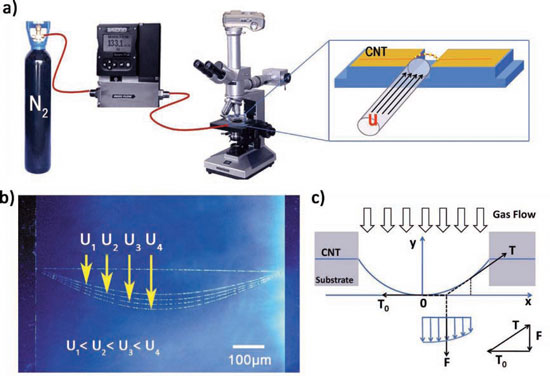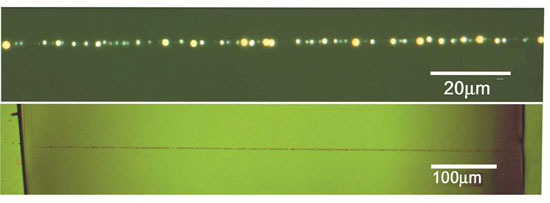| Posted: Jul 11, 2011 | |
Superstrong carbon nanotubes are an effective storage medium for mechanical energy |
|
| (Nanowerk Spotlight) Running a society on renewable energy is not a viable option unless energy generated by windmills, solar cells, hydropower plants and the like can be stored on a large scale and made available during times when energy demand exceeds energy production (for instance at night or during windless intervals). Apart from batteries and fuel cells there are mechanical energy storage options that could play a role: pumped storage hydroelectricity (example: Bath County pumped storage station), compressed underground air storage (example: Huntorf plant), even flywheels (example: Stephentown flywheel energy storage plant). | |
| Energy generation and storage is an equally important issue at the nanoscale. For tiny devices such as nano- and micro-electromechanical systems – NEMS and MEMS – autonomous power sources are crucial for practical applications. Progress is being made in designing and fabricating nanoscale power generators (see for instance: "Nanotechnology converts heartbeat and breathing into electricity". But, as with the large, macroscale systems of future smart grids, there might be times when powered nanodevices need to bridge a slump in power generation/harvesting or they might be designed to run on stored energy altogether for a limited period of time. | |
| Researchers in China are now proposing that the high energy density and power density of carbon nanotubes (CNTs) makes them promising materials for the storage of mechanical energy. Reporting their work in the June 14, 2011 online issue of Advanced Materials ("Superstrong Ultralong Carbon Nanotubes for Mechanical Energy Storage"), a team led by Fei Wei, a professor in the Department of Chemical Engineering at Tsinghua University in Beijing, provides a structural model towards mechanical energy storage for nanodevices and also demonstrates a method to characterize and manipulate ultralong CNTs. | |
| "As we know, carbon nanotubes are the strongest materials ever discovered and have huge theoretical strength, Young's modulus, as well as tensile strain," Wei tells Nanowerk. "It's obvious that such a strong material should have great potential for mechanical energy storage – either by their deformation in composite materials or by their elastic deformation produced by stretching or compressing the pristine tubes. However, carbon nanotubes' theoretically high strength and tensile strain as well as Young's modulus have never before been reported for ultralong, i.e. macroscale, nanotubes. The reason lies mainly in the existence of defects in the fabricated CNTs." | |
 |
|
| Illustration of the gas-flow-blowing system used for testing the mechanical strength of CNT/TiO2 string. The suspended CNT/TiO2 chain was observed using an optical microscope. The elongation of the string was recorded by a digital camera when gas flow was introduced onto the suspended tube section. U in the inset is the gas velocity. b) Elongation of the CNT/TiO2 string with the increasing gas velocity. U 1 , U 2 , U 3 and U 4 represent different gas velocities. The two ends of the suspended CNTs remained fixed during the process. c) Force analysis illustration for a stretched CNT. T is the pull exerted along the axis of the CNT, T0 is the pull exerted at the middle point of the suspended CNT, and F is the drag force exerted on the TiO2 particles. (Reprinted with permission from Wiley-VCH Verlag) | |
| In their new work, the Chinese team has synthesized ultralong CNTs with length over 10 cm with perfect structures and no detectable defects. These CNTs exhibit remarkable properties: a breaking strain of up to 17.5%; tensile strength up to 200 GPa; and Young's modulus up to 1.34 TPa. They could endure a continuously repeated mechanical strain-release test for over 180 million times and remained unbroken. | |
| "The extraordinary mechanical performance qualifies these CNTs with high capacity for the storage of mechanical energy" says Wei. "They can store mechanical energy with a density as high as 1125 Wh per kg and a power density as high as 144 MW per kg." | |
| The manipulation of individual ultralong CNTs is not an easy task due to their nanoscale diameters while macroscale lengths – which is far beyond the characterization scale of the normally used instruments, such as SEM, AFM, or TEM – and their huge van der Waals forces with the substrate, which hampered measurement of their mechanical performance. | |
| To avoid the constraint of normally used instruments, and to get rid of the interference of the substrate, the researchers constructed a special device with individual ultralong CNT as a demonstration platform for mechanical energy storage. They made millimeter-wide slots on a silicon substrate and let ultralong CNTs grow over them so that they lie suspended across the slots and thus are free from interference. Then, in order to make the CNTs visible under an optical microscope, they deposited large amounts of titanium dioxide particles onto them. The result is a bead-like chain formed across the slots on the silicon substrate. | |
 |
|
| Optical microscopy images of CNT/TiO2 strings. Under an optical microscope, titanium dioxide particles are easily observed. (Reprinted with permission from Wiley-VCH Verlag) | |
| "After the titanium dioxide particle were deposited on the CNTs and they became visible under an optical microscope, it became very convenient to manipulate individual CNTs directly and measure their mechanical properties," says Wei. "We could then perform mechanical performance measurements of the CNTs by introducing a steady nitrogen flow to blow the suspended CNTs." | |
| Testing the CNTs this way, the team found that the ultralong nanotubes exhibited excellent strain-relaxation reversibility and high fatigue resistance capability. | |
| "From our vibration tests we can conclude that the working mode of the individual CNTs, which were sensitive to ambient tiny vibrations, is promising for the fabrication of self-powered NEMS/MEMS, flexible devices, sensors, actuators, and antennas" says Wei. "In addition, the CNTs offer a cleaner and safer energy storage manner compared to batteries and super-capacitors. The further scale-up of the CNT system can have astonishing applications due to their ultrahigh strength." | |
| "But" he cautions,"for the ultralong CNTs to be used in daily life in the future, we must make their mass production with perfect structures reliable – which is a big challenge at present." | |
 By
Michael
Berger
– Michael is author of three books by the Royal Society of Chemistry:
Nano-Society: Pushing the Boundaries of Technology,
Nanotechnology: The Future is Tiny, and
Nanoengineering: The Skills and Tools Making Technology Invisible
Copyright ©
Nanowerk LLC
By
Michael
Berger
– Michael is author of three books by the Royal Society of Chemistry:
Nano-Society: Pushing the Boundaries of Technology,
Nanotechnology: The Future is Tiny, and
Nanoengineering: The Skills and Tools Making Technology Invisible
Copyright ©
Nanowerk LLC
|
|
|
Become a Spotlight guest author! Join our large and growing group of guest contributors. Have you just published a scientific paper or have other exciting developments to share with the nanotechnology community? Here is how to publish on nanowerk.com. |
|
